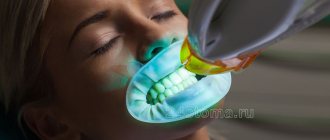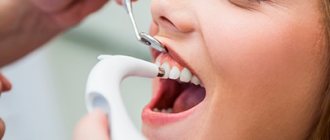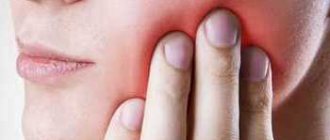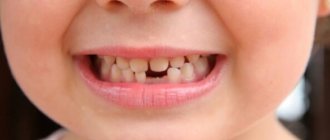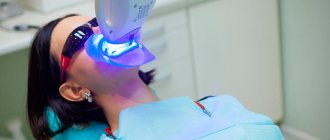- Introduction
- Types of teeth whitening in clinics
- Photobleaching (ZOOM)
- Air Flow
- Chemical teeth whitening
- Ultrasonic whitening
- Endobleaching
- Laser whitening
- Amazing White
- Opalescence
- Beyond Power
- Double White-Belle
- Unprofessional methods
- Traditional methods of teeth whitening
- Assessing tooth color during bleaching
- Accelerating whitening with a lamp
- Is teeth whitening harmful?
- Enamel after teeth whitening
- Teeth whitening for children
- List of foods prohibited after bleaching
- Popular questions about whitening
Over the course of life, the color of tooth enamel gradually loses its whiteness.
There are many reasons for this: smoking, drinking drinks such as coffee and tea, and improper oral care. Sometimes it happens that the teeth are initially dark in color. Currently, this problem can be solved easily and simply. Teeth whitening is carried out using several professional techniques, which the dentist chooses individually for each patient. Teeth whitening allows you to change the color of your teeth in the range of 8-12 shades. The lightening gels used give different light shades to the teeth without changing the properties of their enamel.
Teeth whitening is a fairly modern and quite popular procedure. During whitening, the current shade of the surface of the dentition is lightened. Depending on the intensity of bleaching, the final result may change, but the equipment used most often does not change. The vast majority of clinics use specialized reagents and high-precision dental equipment. All this, in the hands of a professional, gently affects tooth enamel. The expert removes yellow plaque and dark age spots. Please note that bleaching is not a medical operation. Its only purpose is to give teeth an aesthetic appearance.
All methods of lightening enamel can be divided into professional and home. Each technique will find its place in one of these categories. It is worth understanding that the safety of the whitening result directly depends on the patient. The fact is that bad habits, certain coloring foods in the diet and other factors can accelerate the yellowing of teeth. Without timely maintenance of hygiene, teeth will begin to lose their ideal appearance; it is important to keep the enamel clean.
Indications for whitening
You can contact the dentist for a whitening procedure in the following cases:
- Changes in enamel color as a result of smoking or other bad habits.
- Age-related changes in teeth colors.
- White spots on enamel.
- Fluorosis.
- Change in tooth color after pulp removal.
Any discomfort associated with the color of your teeth may be a reason to contact your dentist.
Contraindications
With the advent of new whitening techniques, there are fewer and fewer contraindications for the procedure. However, your doctor may advise you to postpone the whitening procedure in the following cases:
- The patient's age is under 18 years.
- Exposed neck of the tooth due to periodontal disease.
- The enamel is too thin and has cracks.
- Treatment with braces.
- Pregnancy and lactation.
Teeth whitening methods
There are two methods of teeth whitening: professional and non-professional. The first is used both in dental clinics and at home. Professional whitening includes photo whitening, endo whitening, chemical, laser, cosmetic whitening, as well as the use of caps. Each method has its own advantages and disadvantages, indications and contraindications.
Non-professional whitening products include plates that are used with trays. Dentists do not recommend using them yourself: improper use will lead to complications and increased tooth sensitivity.
The most popular and effective are professional methods - chemical, laser and photo bleaching. Professional home whitening methods are also often used, but a course of procedures is required to obtain a lasting result.
The most effective non-professional teeth whitening products are preparations based on hydrogen peroxide or carbamide peroxide. Preparations without these substances only clean plaque and polish teeth.
Even when using the same product, different patients will have different results. The best effect is achieved by whitening teeth with natural yellowness. Gray enamel is more difficult to bleach. An experienced doctor will be able to predict how effective the procedure will be in a particular case.
List of foods prohibited after bleaching
The coloring pigment is found in many components of our everyday diet. Some positions should be abandoned so as not to spoil the result of the procedure. Ideally, you need to follow a “white” diet, that is, rearrange your diet in such a way as to reduce the role of coloring foods. Acceptable positions include:
- Pasta products, bread and rolls.
- Cereals. The grain has no pigment properties, which means it suits us.
- Dairy products, except kefir and other fermented milk products.
- Fish and other seafood.
- Eggs, especially whites.
- Light poultry or rabbit meat.
- Light vegetables and fruits (bananas, potatoes, cauliflower, etc.).
Avoid red wine, coffee and strong tea. Spices like turmeric and curry are also not allowed. Citrus fruits and most berries should be avoided.
Composition of whitening gels
For both professional and non-professional whitening, special gels with hydrogen or urea are used. It may also contain amorphous calcium phosphate, potassium nitrate or fluorine. These elements give teeth brightness and shine and heal damaged enamel. Some gels contain components that have a soothing effect on gums and teeth.
What do experts recommend?
Dentists advise: before choosing a way to improve the color of your teeth, you need to decide what you want to get in the end. If the problem is dark deposits from food, drinks or smoking, then you should first carry out a comprehensive professional cleaning (ultrasound + Air Flow). Perhaps pure, natural-toned enamel is the result you were expecting. If the ideal is a snow-white “Hollywood” smile, then you need to take the next step - perform ZOOM-4. The planned shade can be selected together with your doctor according to the Vita scale. To achieve a more lasting effect, experts advise carrying out this procedure first in the clinic, then performing it at home.
The dental chain offers teeth whitening services using a variety of methods. We have family and cumulative discounts. Doctors are highly qualified and continue to improve their skills in leading Russian and European dental clinics. The level of medical services provided meets international standards.
Branches of our orthodontic center are located in Moscow within walking distance from the metro:
- Art. Alekseevskaya (VDNKh district, etc. Mira), address: st. 3rd Mytishchiskaya house 3, building 2;
- Art. Shelepikha, address: Shelepikhinskaya embankment, address: building 34, building 1.
We will make your smile beautiful! Come to us for health and beauty!
Stages of teeth whitening
- The doctor examines the patient’s oral cavity, determines the cause of the change in enamel color, and takes an x-ray. The information obtained will allow you to select a suitable bleaching system.
- Professional teeth cleaning.
- Remineralization to restore thinned enamel. Performed before and after bleaching.
- Teeth whitening. The doctor applies a whitening gel to the teeth, which is activated by light, laser, or without additional devices. The duration of the procedure depends on the chosen technique, but usually teeth are whitened in one visit.
- Before whitening at home, you should visit a doctor. The specialist will select a special gel and make individual mouth guards. The doctor will also tell you how to properly carry out the procedure. You need to apply gel to the trays and put them on your teeth. The procedure should be repeated twice a day or the trays should be left overnight - it all depends on the technology chosen. Typically, a whitening course lasts 14-30 days.
- After the procedure is completed, the effect is assessed according to the VITA school.
The whitening effect lasts from six months to several years. The exact period depends on many factors. Proper oral care and regular professional cleaning will help you maintain a snow-white smile for as long as possible. To preserve whiteness for a longer period of time, you need to use supporting bleaching agents - pastes, rinses. It is also important to follow a diet.
Even if you follow your doctor’s recommendations and take proper care of your teeth, whitening will have to be repeated after a while. In addition, it will not be possible to completely return your teeth to their original shade.
Alternative Methods
We looked at the main ways to lighten an enamel coating. At the same time, there are techniques that are not classical, but can visually make a smile snow-white. These are intracanal endobleaching and microprosthetics with veneers. The intracanal bleaching technique may be necessary if the tooth has darkened due to pulp removal, trauma, or the use of a colored filling material. Endobleaching involves the introduction of a lightening gel into the cleaned canal, which destroys the pigment. If the teeth are slightly uneven, have a chip or crack, and in addition their color is far from ideal, then the best option in this case would be to install veneers. These are the thinnest plates fixed to the outer surface of the dental elements. At the same time, they are sharpened minimally, and the aesthetics of the smile changes for the better as much as possible.
Contraindications
In some cases, teeth whitening is not just harmful, but unacceptable. Your doctor will determine whether you can whiten your teeth or not. If a patient has contraindications, but still whitens his teeth, he may face serious oral diseases.
Diseases and conditions for which teeth whitening is contraindicated:
- open caries;
- pathological abrasion of enamel;
- deep cracks in teeth;
- gum disease;
- wearing braces;
- exposure of tooth roots;
- allergy to bleaching agents.
In addition, teeth whitening is contraindicated for minors, as well as pregnant and breastfeeding women.
Double White-Belle
The quality of whitening depends not only on the skill of the dentist, but also on the tools used. Find out in advance which whitening system the specialist will use. Perhaps the best representative of all the available options is Double White-Belle. Before using specific patented techniques, the doctor will carefully examine the oral cavity, remove dental tumors, or prescribe additional treatment procedures. When all preparations are completed, it’s time for the actual bleaching.
Using Double White-Belle, the doctor will lighten not only the enamel, but also the surface layers of dentin. Deep whitening will renew your teeth by about 12 layers, which is impossible not to notice. First, as already mentioned, a primary examination is carried out to determine the presence of any formations, deviations and other nuances that may interfere with the correct whitening of the teeth. Afterwards, the doctor does his job and, at the end of the whitening, covers the teeth with a special reminalizing gel. The composition will allow the body to easily endure stress such as teeth whitening.
We have highlighted the Belle system in a separate section for a reason. The gel from this manufacturer has an antiseptic effect, which is especially useful if you are planning your next dental checkup. With Belle you can not only whiten, but also clean your own teeth well. Anti-inflammatory and deodorizing components also occur. To update the treasured 12 layers, you need to carry out 3 procedures. Don't worry, they last only 15 minutes and the effect will last up to 2 years. The main thing is to properly care for your whitened teeth.
Even such a famous system as Belle has a number of contraindications. Whitening should be used if your enamel has changed as a result of addictions, poor diet or age-related processes. However, the procedure should be avoided for children under 14 years of age, pregnant women, breastfeeding women and those suffering from advanced caries. A specialist will remind you of all this in advance.
At this point, you know everything you need to understand before having your teeth whitened for the first time. Follow our recommendations and listen to the advice of your doctor, then updating your smile will become a painless, quick and effective process.
Can I whiten my teeth with store-bought whitening paste?
Most “whitening” toothpastes are not capable of whitening teeth, because... they do not contain an oxidizing agent. Instead of an oxidizing agent, paste manufacturers add a larger amount of abrasive substances to its composition than in conventional pastes, which contributes to more effective plaque removal.
Such pastes cannot be used constantly! Such pastes are suitable for smokers and coffee lovers.
Whitening paste can be purchased at a pharmacy. It will cost many times more than a regular “whitening” paste from the store. A certain amount of oxidizing agent is actually added to its composition. But even with long-term use of such pastes, you may not get a noticeable result. The concentration of oxidizing agent in such pastes is too low.
Such pastes are an excellent addition to home or in-office teeth whitening; they are often prescribed to maintain the whitening results obtained.
I want to whiten my teeth: what should I do?
Whitening, which is prescribed by the doctor during consultation, will be effective. In this case, the result will be individual for each patient. In addition, the visual perception of tooth color is always influenced by lighting, skin color and even the color of clothing.
Teeth whitening can be considered a safe way to improve your quality of life. You will be pleased with the reflection in the mirror, and you will no longer have to hide your smile. Healthy teeth without excess pigmentation look well-groomed and white, even if their natural shade is far from perfect white.
The cost of whitening in our clinic starts from 8,000 rubles without discount. We often hold promotions with good discounts on this procedure, so you have a great chance to evaluate the results of any system.
Prices and effectiveness of teeth whitening in Krasnoyarsk
When you are faced with studying this issue for the first time, the promise of a result of 6-10 shades seems incredible. Usually patients think that this is a lot and just enough to make snow-white teeth out of “ordinary” teeth. But it is not so.
The Vita scale, which shows the main shades of enamel, can be easily found on the Internet. On it you will see that the difference between them is insignificant. Therefore, a whitening efficiency of 6–10 positions will obviously not produce Hollywood whiteness. However, repeated treatment and attention to dental hygiene will significantly lighten the enamel, even out the tone of all teeth and give a natural, clean glow to your smile.
Professional whitening methods
Using modern whitening methods, you can significantly change the color of your teeth. The main mechanism is the penetration of the active substance into the thickness of the enamel, followed by oxidation of the molecule containing the pigment [1].
Currently, the following methods of changing the color of natural teeth are used in dental practice:
- Microabrasion. With this method of treating discolored teeth, a microscopically thin layer of enamel is removed, simultaneously eroded and polished with a special composition containing abrasive and hydrochloric acid.
- Chemical bleaching. This procedure is not aimed at restoring the chewing function of the tooth and does not help prevent dental diseases, but it helps eliminate aesthetic defects and increase the level of social adaptation and quality of life.
- Direct composite restoration. Direct composite veneers are created by layering composite material. To install them, there is no need to take impressions, since the restorations are made directly in the patient’s mouth.
- Installation of veneers (ceramic, composite). The indications for indirect composite restoration are exactly the same as for direct veneers. The production of onlays does not take place on the surface of the teeth, but in the laboratory [2].
Result guarantee
The physiological characteristics of different people are different and the result will also be different. Teeth with a yellowish coating are most amenable to whitening. Those with a gray tint or stains (tetracycline or fluoridated) are more difficult to bleach.
Be prepared that the whitening gel does not affect non-living enamel - artificial crowns, ceramics, polymer composites, and other restorations made from filling materials. After bleaching, all restorations in the visible area will have to be replaced.
Indications and contraindications
Indication for teeth whitening is a change in their color for the following reasons:
- frequent intake of tea, coffee, red wine, smoking;
- pulp hemorrhages
- endodontic treatment using outdated methods;
- age-related changes;
- fluorosis;
- "tetracycline teeth"
Contraindications to the procedure according to the requirements of the American Dental Association (ADA):
- pregnancy and lactation;
- open caries in the smile area;
- periodontal disease during the period of exacerbation;
- destroyed (damaged) seals;
- age up to 14 years;
- allergy to hydrogen peroxide (H2O2).
Home whitening
Both home and clinical whitening should be professional. You cannot use soda, lemon juice or activated carbon according to advice from the Internet. All these methods lead to thinning of the enamel. The appearance of cracks and chips is also possible. Why? The condition of everyone's teeth is different, as is the level of sensitivity. Do you know how strong your enamel is? How long does the composition need to sit? What will be the result? Hardly. Without this knowledge, safe whitening is impossible. That is why, even before using home methods, consult your doctor. Is it right for you? Will this procedure be harmless? Is the result worth it?
Options for gentle teeth whitening at home:
- Home whitening ZOOM. Dentists recommend using this method additionally to prolong the effect of professional whitening. Zoom at home is performed using a special mouthguard and a bleaching agent. With its help you can lighten enamel up to 6 tones. The mouth guard is either worn during the day or worn at night. But due to the different concentrations of the active substance, before using this whitening system, you need to consult a doctor who will tell you how to whiten your teeth enamel correctly. In addition, oral diseases must first be cured: caries, gingivitis, periodontitis and others. Also, you will need a professional hygiene procedure to achieve a uniform effect. So you won’t be able to avoid a visit to the dentist.
- Home whitening strips. The strips contain a low concentration of peroxide gel - about 6%. You can buy them at the dentist. This method allows you to whiten your teeth by 4-6 shades or improve the result of previously performed professional whitening. The disadvantage of strips is long-term use - one course takes 2-4 weeks. However, you need to use them every day. The effect will last up to a year.
Finally, how to whiten teeth without harm? If you want to whiten your teeth quickly, efficiently and without unpleasant consequences, contact your dentist. From the list of possible options for procedures, everyone will find their own. It is important to remember that the duration of whitening results depends on your daily dental care and nutrition. Carry out comprehensive dental care, visit the dentist twice a year, limit the consumption of coffee, tea, and other coloring products. These measures will extend the whiteness of your smile up to 7-10 years.
Effect duration
The gradual appearance of plaque and pigments is a natural process. Re-yellowing of enamel occurs slowly, but can be accelerated by frequent use of coloring pigments in products.
Thus, the duration of the effect is influenced by:
- diet and eating habits - with daily exposure to dyes, the duration of the effect decreases;
- enamel permeability - teeth with increased permeability are more susceptible to dyes, they turn yellow faster than teeth with average or low sensitivity. It is impossible to determine the thickness of the enamel in advance, except for personal observations.
If the permeability of teeth is increased and they regularly come into contact with dyes, the effect will last for 6 months. If the enamel has low permeability and rarely encounters dyes, the result lasts up to 2 years. For patients at risk of pigmentation, the teeth are coated with an insulating protective sealant. This protects cleaning efficiency.
